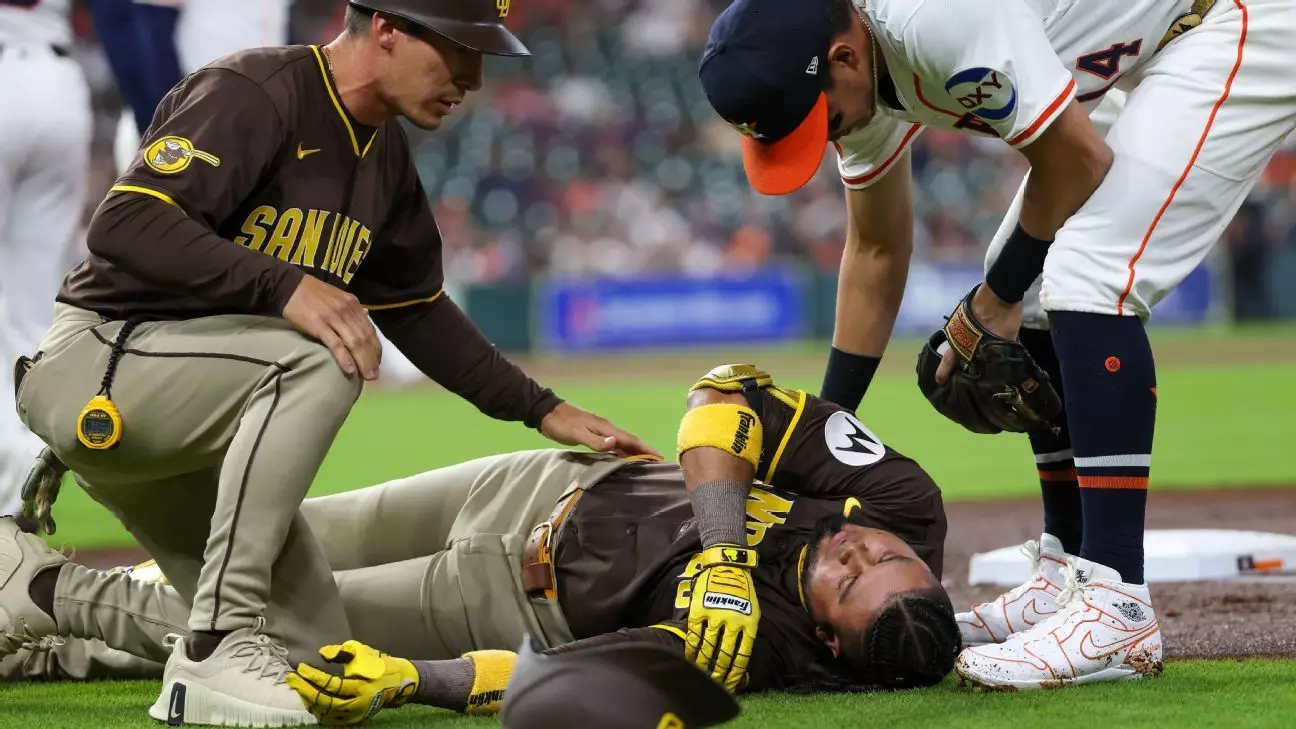In the heart of a thrilling matchup between the San Diego Padres and Houston Astros, an alarming incident unfolded on a seemingly routine play. Luis Arraez, a celebrated three-time batting champion, suffered a concussion after a collision at first base with Mauricio Dubon. This intimidating event sent shockwaves through the baseball community, highlighting not only the physical dangers players face on the field but also the emotional gravity of such injuries. As Arraez lay motionless, the grim reality of sports injuries was starkly evident, leaving fans and players alike on edge.
The collision occurred as Arraez attempted a drag bunt, a scenario that ordinarily shouldn’t cause alarm. Unfortunately, things took a critical turn as he collided with Dubon, striking his face against the second baseman’s arm. The silence that blanketed the stadium was a haunting reminder of how quickly the game can shift from joy to concern. The swift reaction from athletic trainers and coaching staff underscored the severity of the situation; Arraez was placed on a backboard and transported from the field, initiating a wave of anxiety amongst everyone present.
A Collective Sigh of Relief
In the aftermath of the incident, the news evolved from grim to cautiously optimistic. After Arraez was taken to the hospital, he returned to the ballpark, buoying the spirits of his teammates and fans. Padres’ manager Mike Shildt conveyed the heartwarming sentiment that the initial prognosis was “very favorable relative to how scary that looked.” This momentary reprieve was a celebrated turning point—Arraez was alert, engaged with his teammates, and showed minimal signs of severe injury beyond some neck stiffness and a small cut.
The announcement that Arraez would enter the concussion protocol, while disappointing, illustrated the team’s commitment to player safety. It’s a paradigm shift in sports where, in the past, players may have been pushed to continue despite injuries. Today’s mindset prioritizes health, reflecting a growing awareness of concussion risks in sports. Shildt’s comments—“it’s as good as we could possibly expect”—served as a comforting reminder of the resilience of athletes and the significance of collective support from teammates during distressing times.
The Broader Implications of Injury
While Arraez’s injury is a focal point, it also sheds light on the emotional toll such incidents take on fellow players. Dubon, who was part of the collision, expressed a blend of relief and a sense of burden, revealing how deeply such accidents can affect an athlete’s mental state. “It was scary,” he said, reflecting a sentiment all too familiar among players. The weight of responsibility can be crushing, and the unfortunate reality is that accidents happen, sometimes leading to extreme backlash, including unfounded vitriol from fans. Dubon’s candid admission regarding death threats showcases the darker side of sports culture, where the stakes are often exaggerated and blame is misdirected.
The support shown by Arraez’s teammates—Fernando Tatis Jr. and Manny Machado, among others—during these trying moments emphasizes not only camaraderie amongst the players but also the emotional fragility inherent in competitive sports. Tatis’s emotional reaction perfectly illustrates the game’s duality; it can be a source of joy and heartbreak all at once. Such scenarios awaken a greater sense of understanding that athletes are multifaceted individuals grappling with physical and emotional battles.
A Resilient Spirit in the Face of Adversity
As Luis Arraez embarks on his recovery journey, the wider baseball community rallies behind him. His stellar performance statistics, including a .287 batting average with three home runs, reflect not just a keen athletic acumen but an indomitable spirit. Having won three consecutive batting titles showcases his tenacity and high caliber of play.
Whether or not Arraez can swiftly return to form remains uncertain, but his history of overcoming challenges suggests that he has the mental fortitude to rebound. The resilience of athletes like Arraez invokes a narrative of strength, tenacity, and determination that resonates beyond the game itself. Indeed, the heart of a champion extends far beyond the diamond—it’s an emblem of overcoming adversity while uplifting those around you.
In the end, the collision serves as a stark reminder that sports, while exhilarating, carry risks that can shape the lives of players. The support and compassion exhibited by teammates pave the way for recovery, creating a tapestry of mutual respect that underscores the camaraderie built both on and off the field.


Leave a Reply